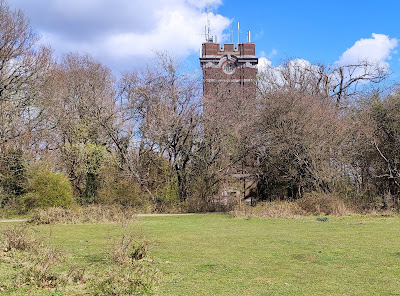Penshurst station is only two stops from Tonbridge on the line towards Redhill, and because I'm going against the flow of commuting traffic, the trains are not too crowded. When they pull in at Tonbridge station each morning, before making the return journey to Redhill, the sheer volume of school kids they disgorge onto the platform has to be seen to be believed.
This is because the town is a centre of educational excellence with two girls grammar schools (equivalent), one boy’s grammar, plus two other schools, one for each sex. One of those is Eileen’s old school, which had something of a reputation, back in the day, plus the comprehensive where Matthew spent six years of his life, getting up to mischief and not really learning as much as he should have done.
So speaks the judgmental parent, but against this background, it’s small wonder that property prices in the area are so high. Trains on the Tonbridge-Redhill line operate on an hourly basis, although at morning and early evening peak times, there were two services every hour, in both directions. This works out fine for work, but even so, I'm looking forward to the return of my vehicle, when we return from holiday. Now for a few interesting facts about this rail line, which forms an important east-west, cross-country link. The railway between Tonbridge and Redhill was part of the original line from London to the Channel coast and after following the course of a natural gap in the chalk hills, to the south of the capital as far as Redhill, departed from the mainline and turned east towards Tonbridge, Ashford and ultimately, Folkestone. It wasn't until the 1870’s that the more direct route north-west, via Sevenoaks was opened, its construction prior to this having been hindered by lines of steep hills, namely the North Downs and the Greensand Ridge. Crossing these natural barriers necessitated building several tunnels as well as a number of deep cuttings. When I first moved to Tonbridge in the mid 1980’s, the line towards Redhill was operated by diesel multiple units (DMU’s for the train anoraks out there), but a few years British Rail finally found the funds to electrify the line, a move which provided a seamless link into the rest of the South East rail network. As well as a busy line in its own right, the link between Tonbridge and Redhill, serves as a useful diversionary route, which is particularly useful when engineering work is taking place on the line that runs through Sevenoaks. Even before electrification I became quite familiar with this line, particularly during the early days of my involvement with West Kent CAMRA. The railway facilitated evening visits to pubs, such as Little Brown Jug, opposite Penshurst station, as well as for visits to pubs in small town of Edenbridge. If we were feeling really adventurous, we’d continue to the end of the line at Redhill, where the Home Cottage, a large Victorian pub belonging to Young's brewery, served as the ideal meeting point for joint socials between WK CAMRA and the local Reigate & Redhill branch.I made a return visit to the Home Cottage last year, whilst
waiting for a connection back to Tonbridge. This was after completing a section
of the North Downs Way. The Tonbridge-Redhill line proved especially useful
whilst walking other sections of this long-distance footpath, along with the western
extension of the line towards Guildford.
 This section, known as the North Downs
Line, is still awaiting electrification,
This section, known as the North Downs
Line, is still awaiting electrification,
something that is unlikely to happen
given the fragmented nature of the rail network, and the botched privatisation designed
for the benefit of shareholders, at the expense of passengers and rail workers. Diesel, or not this section of line was very useful towards
the end of my NDW, as it allowed me to access various stopping off points along
the way, at remote stations such as Betsworth and Gomshall, as I walked towards
the penultimate section of the walk, between Guildford and Farnham.










4 comments:
Paul,
As for "a few interesting facts about this rail line", though of course not of interest to every single one of your readers, I returned yesterday from three nights in Sussex but before going had learnt a bit about the railway line between London and Brighton.
Wivelsfield railway station, where I might have changed for Lewes from my Thameslink service, is actually in the World's End suburb of Burgess Hill and a full 2⅓ miles south-west of Wivelsfield village.
The 96 foot high Ouse Valley Viaduct was built of roughly eleven million bricks that were mostly shipped up the River Ouse, via Newhaven and Lewes, from the Netherlands. It has been described as "probably the most elegant viaduct in Britain".
The London Road Viaduct in Brighton was built of nearly as many bricks.
But with residing in the next county you probably knew all that anyway.
Both structures are impressive Stafford Paul, although probably more so when viewed from a distance, rather than from a train traveling directly over them. Like many similar examples of Victorian civil engineering up and down the country, these viaducts were certainly built to last, especially as they are in daily use.
I wonder why the builders of the railway chose to import the bricks from abroad. Perhaps the local brick-works couldn't produce sufficient quantity to match that sort of demand.
Paul,
Yes, "probably more so when viewed from a distance" must be a bit like Stockport's from the outside lavatory of the Crown,
I've been quite close to the Stockport Viaduct Paul, but not that close. I'm pleased to learn that one or two pubs still have an outside lavatory - the Gents, I presume!
Post a Comment